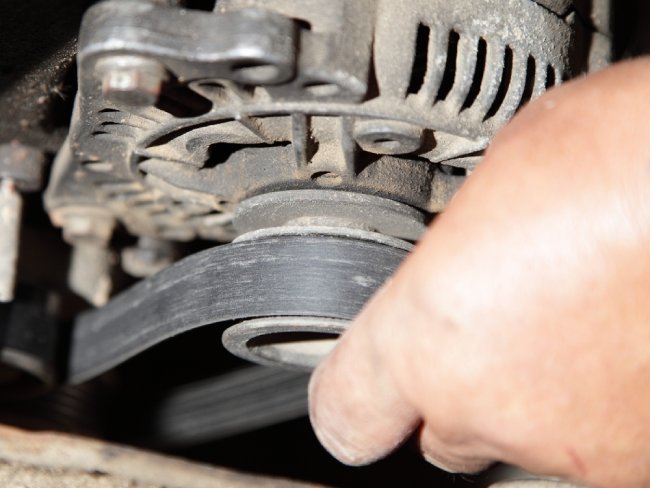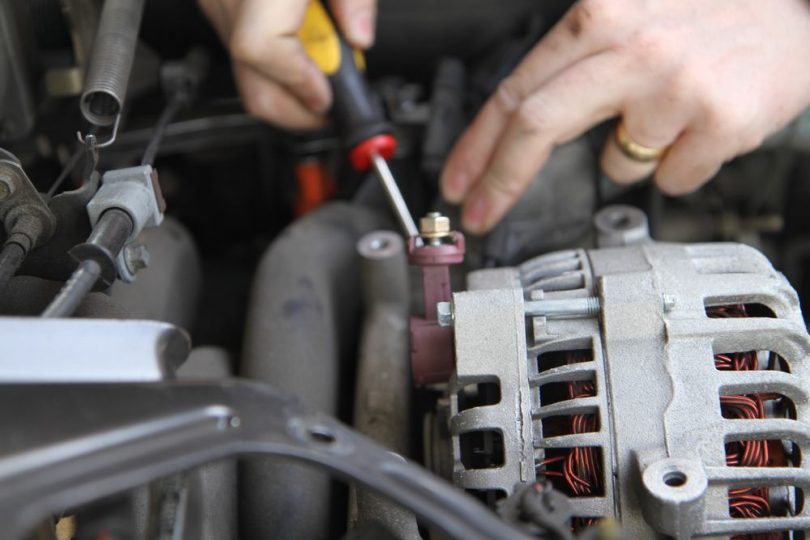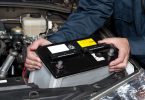People are often confused about the battery and alternator and how they work. While electronically, it is complicated. Their jobs are pretty simple. Your battery is vital when starting the car. With the help of the engine, the vehicle starts when you turn the key. The alternator supplies the power and charges the battery as you drive.
Here we’ll look at signs of a bad alternator, why the alternator goes bad, and several methods to test the alternator, including testing the alternator by disconnecting the battery.
The alternator’s job
The electronic components in your vehicle like your dashboard, radio, power windows, and headlights need a direct current (DC) to work as you drive. The alternator supplies this power and continually charges the battery as you drive.
The alternator supplies this by turning mechanical energy into the electrical power the vehicle needs. As the engine starts, a pulley on the alternator turns its rotor shaft spinning the coil magnets. These magnets create the alternating current (AC) on the coil. The AC power is converted into DC power by the rectifier and runs the electrical things in your car.
Signs of a Bad Alternator
1. Electrical issues
Your power window rolls up and down much slower, or the instruments on the dashboard aren’t functioning correctly. The alternator isn’t supplying enough DC to let them work properly.
2. Dimmer or brighter headlights
A faulty alternator produces an erratic voltage to electronic components. Your lights may be much brighter than usual, dimmer, and even flicker. This is often blamed on the battery when it is an alternator issue.
3. Lit battery light on the dashboard
When a battery warning lights the dash, it’s telling you there is a problem with the electrical system; this includes the alternator. The battery gets a check when the alternator is the problem.
Your alternator needs 13-14.5 volts. When the voltage is less than this, the battery light comes on. It will also pop on if the voltage exceeds 14.5, especially if the alternator is under stress. The dashboard light may flash if the voltage is ramping up and slowing down. This is a bigger issue than you think and the car should be checked as soon as possible
4. Battery is dead
A dead battery is usually caused by cold weather, a door that was not closed right, or a light left on in the car. While these cause a dead battery, a faulty alternator that cannot charge the battery as you drive will also cause the battery to die.
Tip: Jumpstart the car. If it dies soon after the jumpstart, it is the alternator. If it starts and stays running, you probably need a new battery, unless you left something on when you locked the car.
5. Whining and growling
Let’s face it. Cars make lots of noise. Most aren’t a big deal, but if you hear whining or growling, the alternator’s pulley belt is out of whack, or the rotor shaft bearings are going.
6. Burning smell
When the alternator works harder than usual, or some wires have been damaged, they impede the flow of electricity, making the wires hot and giving off a nasty odor.
You can smell burning rubber if the pulley bearing on the alternator freezes while your engine runs.
Engine stalling
When turning the key in the ignition, it clicks instead of starting, the alternator can’t charge the battery, and the clicking is the engine trying to start.
How to Test an Alternator by Disconnecting the Battery?
Step 1: Move the car to a safe spot
You must pull over to a safe spot if you are doing this while on the road. If you are at home, the driveway or garage is ideal.
Step 2: Start the car
Starting the car will give you a good idea if it is the alternator.
Step 3: Car battery disconnection
Once you know it’s the alternator, let the car run and open the hood. Locate the red positive battery terminal and disconnect it. This will allow you to test the alternator without harming anything else by removing the power source from the electrical system.
Warning: Don’t touch any part of the car while it is disconnected!
Step 4: Is it still running
Once you disconnect the battery and the car is still running, the alternator is good. If the vehicle runs for a few minutes and then dies or doesn’t start, it is an alternator problem.
A cooling leak issue can be mistaken for an alternator issue. Disconnect the battery and if the car stalls, BUT you hear the alternator continue to run, check the cooling system.
Step 5:
Once you know the problem, you can fix it yourself or see a mechanic.
Is disconnecting the battery safe?
It is not the recommended way to check the alternator. Disconnecting the battery can seriously damage an alternator and create other problems for the car and its electrical system. Use it only in a pinch!
Other Better Methods to Check the Alternator

1. Voltmeter /multimeter method
First, with the car off, touch the prongs to the battery terminals (black to black, red to red). You should see a reading between 12 and 13.
Second, turn the car on and repeat the first step. The reading should be between 13 and 14, which is ideal for a good alternator.
A reading that decreases or remains the same with the car running is a reason to have the car looked at.
2. Alternate multimeter method
Repeat the first step in the above method to get a baseline reading. Then with the car running, turn on all the accessories (AC, radio, windshield wipers…). Now check the readings at the terminals. If the readings go below the initial reading, the output stresses the alternator and needs inspecting.
3. Screwdriver method
Do this with a key in the “on” position and the dashboard lights lit.
Step 1: With the key in the on position, so the dashboard lights on, locate the alternator in the front of the engine and the serpentine belt attached to it.
Step 2: Touch the screwdriver’s tip to a nut on the alternator closest to the pulley. Be careful not to touch other parts of the engine. You should feel a strong magnetic pull, meaning the alternator is good.
If there is no magnetic pull, have the alternator checked.
While this is a good way to check the alternator in a hurry or out on the road, it is not as reliable as testing with a multimeter.
Causes of a Faulty alternator
1. Blown Fuse
A blown fuse can short out the alternator creating a burning smell and high-pitch noises.
2. Problems with the electrical wiring
Loose connections to the alternator are commonly caused by wires that are exposed or corroded. Severed wires or faulty connections may result in the car taking longer to start or headlights flickering.
3. Fluid leak
The battery and alternator will be damaged if there is a coolant leak due to the overheating, it can cause.
4. Exposure to moisture
Alternators are not waterproof but resistant to moisture such as rain and snow. If you are in deepish water like a flood or very deep puddle and the alternator doesn’t dry fast, it can potentially damage the alternator.
5. Improper use of jumper cables
If you don’t know how to use jumper cables, you can damage the alternator by using them incorrectly.
6. Accessory overload
Using accessories that require more voltage than the alternator can supply will stress the alternator and burn it out.
7. The belt is too tight
If the alternator belt is too tight, it will damage the bearings and ruin the alternator.
How to keep a smooth running alternator?
1. Look for Damage
Do periodic checks of the alternator and battery to catch issues before they are significant.
2. Keep it clean
Remove any grease or debris that will keep the heat in and cause the alternator to overheat.
3. Is there an electrical connection?
Remove corrosion and replace wires and connectors that are loose or cracked. Remove corrosion from the battery terminals so the connection remains strong. Check the belts to ensure they are tight enough or not too tight or misaligned.
FAQs
1. How long should an alternator last?
Ans. Most alternators should last as long as the car. An alternator’s longevity is affected by heat damage, water exposure, inferior parts, fraying of wires, and everyday use. Periodic inspection and good maintenance will increase the life of your alternator.
2. What is the cost to fix the alternator?
Ans. The cost depends on the vehicle’s make and model—alternator replacement costs between $350 and $700.
3. Can a car run with a faulty alternator?
Ans. It is not a good idea to drive with a bad alternator. The battery is not charging while driving with a faulty alternator, and the battery will be supplying the electricity for the car. If there is flickering of the accessories, or they shut off, you’re losing power. Call a tow truck and wait for help.










Leave a Comment